#christian laettner
Text

#michael jordan#patrick ewing#christian laettner#larry bird#karl malone#david robinson#chris mullin#scottie pippen#charles barkley#john stockton#magic johnson#clyde drexler#dream team#team usa#usa#nba#nba basketball#basketball legends#nba legends#legends#champions#shooting guard#point guard#power forward#small forward#center#1992 olympics#1990s#90s#90s classic
10 notes
·
View notes
Photo
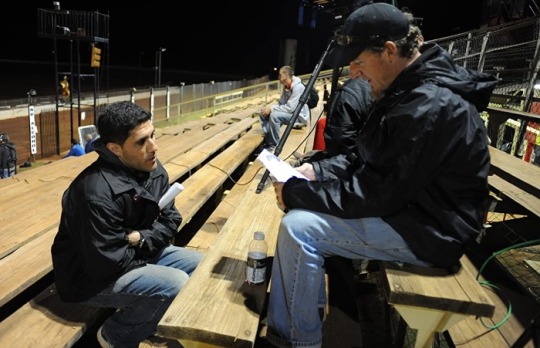
Why Long Movies Don’t Work - Rory Karpf via FilmCourage.com.
youtube
#30 for 30#NFL#movies#film#sports#Christian Laettner#duke university#basketball#documentary#cinema#pop culture#media#entertainment industry#film and tv#making movies#producer#filmmakers on tumblr#producers on tumblr#news#last dance#espn
0 notes
Text
Sometimes I read posts on here and I realize that things I thought were fairly universal aren't, actually.
Got a post saved in my drafts about critical thinking so I can check the notes and think about it. It features a story about a high school teacher - note high school, not elementary - doing a really really basic exercise about critical thinking. And the notes are full of people saying wow I wish I had a teacher like that and great teaching and that sort of thing. It also mentions the students being a bit upset at first and accusing the teacher of confusing them, because they automatically believed anything the teacher said and when the teacher offered two sides of something and asked them to research and make up their own minds it weirded them out.
I am trying to remember if I have any stories from school but honestly I don't remember my classes very much. The formative experience from my childhood that I do remember and that I very often reference is when I read every book the local library had on the Holocaust when I was 9.
Wait....I am remembering something from sixth grade now. A research paper on escapes from POW camps during WWII. And an 8th grade group report on..I want to say WWII because if we got to pick our war of course I went with that one...that the teacher said my group should kiss my feet for. I'm not sure though because I think I remember playing a Johnny Horton song for the presentation and the only Johnny Horton song I can remember right now about war is The Battle Of New Orleans which is about the War of 1812. Wait wait, there's Sink The Bismarck about WWII!
Anyway, my point is that high school seems really late for learning about propaganda and learning to tell decent sources from obvious propaganda. But then like I've said before, I graduated in 1999 so I don't know what school is like now with NCLB.
Also I went to rural working class schools and the local library was of course a small rural library, so nothing special or particularly privileged or anything. So I never think that I was particularly privileged or weird or an outlier until I see Tumblr posts like that one where a lot of people agree that they had experiences completely different than mine, and I'm like ohhhh this explains a lot about the internet.
I bet they don't even let them watch ACC basketball tournament games in class anymore. Our teachers would roll in those TVs and we'd get to watch the games as long as we also quietly did our work.
#one thing the spousal person and I both definitely remember from our childhoods#Is Christian Laettner's three pointer from half court#to win against Michigan in the 1992 NCAA tournament#if you grow up in NC you are a college basketball fan#you don't get a choice in that
6 notes
·
View notes
Text
so-called "sonic dream team" yet there's no sign of Christian Laettner
smh my head
0 notes
Video
youtube
What Impressed Christian Laettner The Most About Michael Jordan? His Def...
0 notes
Text

∀ Christian Laettner Duke Signed Blue The Shot Basketball Jersey PSA http://blog.collectingall.com/T4lb6F 📌 shrsl.com/4fujm 📌
0 notes
Link
[ad_1] Thirty years later, Christian Laettner isn’t sure he knew it was coming. In 1994, he was in the NBA, his second season with the Minnesota Timberwolves. Maybe someone had informed his agent but he doesn’t think so.The former Duke star just one day remembers seeing the commercial on ESPN. Chris Farley, then at the height of his “Saturday Night Live” glory, dressed in Laettner’s No. 32 jersey, recreating his buzzer-beating shot against Kentucky, a signature moment in NCAA Tournament history.“All I know is that all of a sudden it was out and it was hilarious and it was awesome,” Laettner told The Athletic.Farley did three spots that aired on ESPN, all promoting college basketball, all remembered for the physical comedy and shenanigans that made Farley so beloved and famous.In one spot, Farley was Michigan’s Rumeal Robinson, standing at the foul line, needing to sink two free throws to win the 1989 national championship. “And he makes it look … ” Farley says, before firing and missing, not once, not twice but six times, yelling out in famed Farley frustration (“GET IN THERE!”) after each brick.In another, he’s North Carolina’s Michael Jordan in the 1982 title game, but instead of sinking the winning jumper from the wing, Farley decides to take a step-back 3 (he was ahead of his time on this), correctly pointing out in the end that college basketball did not have a 3-point line at the time.But it’s the Laettner ad that’s so fantastic, so funny, so Farley.“OK, I’m Christian Laettner,” the comedian begins, wearing a tight Duke uniform. “1992. Duke-Kentucky. Kentucky’s up by one, Christian’s got the ball. Two seconds left.”Farley turns and faces five Kentucky defenders, life-sized cutouts made from plywood. He dribbles and shoots a turnaround jumper, just as Laettner did that memorable afternoon in Philadelphia in the East Regional final.Nope.“Off the glass!”“Gets his own rebound!”Miss.“Loose ball!”Farley dives and knocks over a Kentucky cutout. Finally, he banks in a layup and raises his arms in celebration.“Duke wins! Game of the century,” Farley yells. “And that’s the way it happened! … Well, almost.”Actually, this is how it happened.In 1993, Glenn Cole worked at Wieden+Kennedy, an ambitious advertising firm based in Portland, Ore. Although it’s a global agency today, Wieden+Kennedy back then devoted a bulk of its resources to one client, Nike. It was known for “Bo Knows” and for Mars Blackmon telling Jordan, “Money, it’s gotta be the shoes.”A copy writer, Cole, 24, was the youngest at the firm. A former sprinter at the University of Oregon, he loved the creativity and story-telling advertising provided, especially at Wieden+Kennedy. He described himself in that environment as an “idiot who was an intern half a minute ago.” But his superiors thought enough of him to assign him an ESPN campaign that came with a simple task.Promote college basketball.“Got the keys to this kind of cool car. Nobody’s looking at it,” said Cole, referring to all the attention the firm gave to Nike. “I have an ESPN basketball campaign. I watch a lot of ‘Saturday Night Live.’ And I was obsessed with Chris Farley.”Cole had an idea. A common basketball moment — playing solo on a playground. Tie game. Clock winds down. 3 … 2 … 1.Yet the shot seldom drops. The countdown resets. No game-winning heroics, only an asphalt do-over.“And so I thought that’d be funny to kind of screw with that trope,” Cole said. “And then I was like, ‘Oh my God, Chris would be the perfect person to do that.'”Approaching 30, Farley was a rising star. The New York Daily News had called him the breakout performer of SNL’s latest season, one who had brought the same sort of “volcanic, magnetic energy” as Eddie Murphy and John Belushi before him. His talent and comedy had started to transfer to the big screen. “Tommy Boy,” which starred Farley and David Spade, would open in 1995.Even better in this case: Farley was a sports fan. Growing up in Madison, Wis., he had played hockey and football. At Marquette, he had played club rugby. At SNL, he played pickup hoops with cast mates at 76th Street Basketball Court at Riverside Park.“Chris was a gifted physical comedian,” said Doug Robinson, Farley’s agent. “And a lot of people don’t know that Chris really was a tremendous athlete. He moved really well. He loved sports. So if Chris was going to do physical comedy, he was going to commit to whatever it is that he did.”Cole flew to Los Angeles to pitch the concept to Farley. ESPN asked if he had a back-up plan in case Farley declined. “Of course,” Cole said.Actually, he did not.“I remember thinking, ‘This is a long shot,'” said Beth Barrett, a producer on the campaign. “It was back in the time when it wasn’t as common as it is now for celebrities and celebrity athletes and comedians and musicians to sell out to commercials. It was almost like a bad thing to be in a commercial.”Cole met Farley in Farley’s hotel suite. Farley wore a tweed suit, disheveled by design. Cole pitched his vision, and Farley grasped it immediately. The comedian got off the couch and started acting out the Laettner spot. He knocked over a vase, which made Cole instantly realize: “Oh, I have to get something for you to knock over.”“Yeah, this sounds like a lot of fun,” Cole remembers Farley saying. “Let’s do it.”The spots were shot days later at a Los Angeles studio. Today, a celebrity likely would show up with an entourage of sorts. But back then, Larry Frey, the creative director on the campaign, recalls Farley’s manager arriving early and Farley pulling up later by himself. Spade dropped in around lunchtime.“He was literally like a 10-year-old kid, and they just called recess,” Frey said. “Full of energy. Like, ‘Hey, guys! I’m probably going to screw it up today.‘ Super self-deprecating. Super enthusiastic. And just winging it.”They shot the Michigan and North Carolina spots first, mostly because Cole knew what Farley had planned for Laettner and did not want to risk his star getting hurt.(In addition to the ads, Farley also shot a series of promos that never aired. In the one below, Farley holds two stuffed animals and pantomimes a conversation about an upcoming rivalry game. Of course, the mascots soon attack each other, and then Farley, and the promo ends with a trademark Farley outburst.)For the Laettner spot, Cole provided simple instructions.“Look, I’m going to put you at the 3-point line,” he recalled telling Farley. “We’re going to start this play the way everybody remembers it in our collective memory. And then look, man, try and make the shot, but if you don’t, just hurry up and try to finish the play and surprise me.”Farley, unleashed.Farley at his best.He barreled through cutouts of former Kentucky standouts Deron Feldhaus, John Pelphrey and Travis Ford, knocking them to the floor.“A whirlwind,” Barrett said.Good ideas don’t always translate. Cole knew instantly this one did.“In every single one of them, right after the first take of every spot — all three — I was like, ‘Ah, f—, this is going to be incredible,'” he said.In “The Chris Farley Show: A Biography in Three Acts,” authors Tom Farley Jr. and Tanner Colby describe this period as the highpoint of Farley’s life.The comedian had battled drug and alcohol addiction, but after a trip to an Alabama rehab facility, he was trying to stay clean. Farley was confident and self-assured, the authors wrote, but it ultimately was a losing battle. In 1997, Farley died of an overdose at age 33.When Cole and Barrett look back on that day in Los Angeles, the experience stands out as much as the finished product. Farley had performed as usual on camera. (After every take, he’d ask: “Was that funny?”) But he was also personable and engaging the entire eight hours he was there.“We’d go hang out in the green room between set-ups and he asked questions and was interested in other people,” Barrett said. “And just (be) kind of a goof. It was just one of those experiences that was pretty rare in advertising where you actually really got to know somebody by the end of the day. It was pretty great.”Farley and Cole had connected so well, riffing back and forth, exchanging ideas, Farley had asked him if he had interest in writing for him at SNL. Cole panicked, thinking, “What if I can’t jam out great stuff every week?” It was an incredible offer, but Cole loved what he was doing. He declined.“That was my third project in advertising as I recall, but it was the first one where I felt like I was collaborating with somebody to make something better than I or he could make independently,” said Cole, who today is co-founder and chairman at 72andSunny, a global ad agency.A year or two after the commercials aired, Laettner walked on a jetway, about to board a plane. He does not remember which airport or where he was headed, but as soon as he boarded he spotted a familiar face sitting in first class. It was Farley.Like most celebrities, Farley was looking down, trying not to get noticed, but he made eye contact with Laettner. Farley stood, and the basketball star and comedian embraced and shared a laugh.“Awesome commercial,” Laettner told him. Chris Farley and Glenn Cole, backstage at the college basketball commercial shoot. (Courtesy of Glenn Cole)(Top illustration: Daniel Goldfarb / The Athletic; photos and videos courtesy of Glenn Cole) !function(f,b,e,v,n,t,s) if(f.fbq)return;n=f.fbq=function()n.callMethod? n.callMethod.apply(n,arguments):n.queue.push(arguments); if(!f._fbq)f._fbq=n;n.push=n;n.loaded=!0;n.version='2.0'; n.queue=[];t=b.createElement(e);t.async=!0; t.src=v;s=b.getElementsByTagName(e)[0]; s.parentNode.insertBefore(t,s)(window, document,'script', 'https://connect.facebook.net/en_US/fbevents.js'); fbq('init', '207679059578897'); fbq('track', 'PageView'); [ad_2] Source link
0 notes
Link
Check out this listing I just added to my Poshmark closet: VTG Dunkin the Timberpup! 1992 MN Timberwolves Plush SIGNED Christian Laettner.
0 notes
Text
Storie delle Olimpiadi: L’impresa del Dream Team di Barcellona

A Barcellona nelle Olimpiadi 1992 il basket venne dominato dal Dream Team degli Stati Uniti, un gruppo che, oltre a Michael Jordan e al suo amico Scottie Pippen dei Chicago Bulls, comprendeva nomi come Larry Bird dei Boston Celtics, Charles Barkley dei Phoenix Suns, Patrick Ewing dei New York Knicks, Clyde Drexler dei Portland Trail Blazers, John Stockton e Karl Malone degli Utah Jazz, Chris Mullin dei Golden State Warriors, David Robinson dei San Antonio Spurs e il collegiale Christian Laettner.
Il gruppo era guidato da Magic Johnson, leader carismatico determinato a tornare in campo dopo aver dichiarato la sua sieropositività il 7 novembre 1991 e riuscì ad abbattere i pregiudizi verso l’Aids con una comunicazione trasparente, facendo informazione sul tema.
L’ignoranza sulla distinzione tra AIDS e HIV diminuì con il tempo anche grazie alla dedizione alla causa di Johnson, un uomo capace di parlare alle persone, ribaltare i luoghi comuni, scuotere le coscienze e dare un messaggio di speranza.
Allenatore del Dream Team era Chuck Daly che definì quell’esperienza “Un viaggio con 12 rockstar. Era come se avessero messo insieme Elvis e i Beatles”.
I professionisti della NBA, alla loro prima apparizione ai giochi olimpici, vinsero otto partite su otto con uno scarto medio di 44 punti, mentre la finale contro la Croazia del talentuoso Dražen Petrović e dell’astro nascente Toni Kukoč terminò con il punteggio di 117-85., con una medaglia d’oro conquistata dopo due settimane di pura esibizione con protagonisti i giocatori e le loro storie.
Durante gli allenamenti a porte chiuse il gruppo cercò di trovata il giusto equilibrio di un gruppo composto da grandi personalità, come Magic Johnson e Michael Jordan e, se il primo aveva contribuito a rilanciare l’immagine della Lega dopo anni bui, il secondo la stava proiettando in un grande cambiamento, grazie ad una mentalità vincente fuori dal comune e una leadership in grado di motivare i compagni di squadra.
Il Dream Team diventò leggendario per la capacità di unire le gesta di grandi atleti a messaggi di inclusione sociale e contribuì in modo decisivo a promuovere l’immagine della NBA in tutto il mondo, al punto che Commissioner David Stern intuì che la crescita del mondo del basket passava dall’allargamento del bacino di utenza oltre gli Stati Uniti.
L’apertura a giocatori africani, asiatici ed europei permise alla Lega di diventare il primo fenomeno sportivo globale, oltre all’arrivo di leggende come Shaquille O’Neal, Kobe Bryant e LeBron James e niente fu più come prima nel mondo del basket americano e non solo.
Read the full article
0 notes
Text
Dream Team
The 1992 United States men's Olympic basketball team, nicknamed the "Dream Team", was the first American Olympic team to feature active professional players from the National Basketball Association (NBA). The team has often been described as the greatest sports team ever assembled.
At the 1992 Summer Olympics held in Barcelona, the team defeated its opponents by an average of 44 points en route to the gold medal against Croatia.
The team was collectively inducted into the U.S. Olympic Hall of Fame in 2009, the Naismith Memorial Basketball Hall of Fame in 2010, and the FIBA Hall of Fame in 2017. The Naismith Hall of Fame calls the team "the greatest collection of basketball talent on the planet". In addition to the team induction, 11 players and three coaches have also been inducted individually into the Naismith Hall of Fame.
Dream Team Roasters :
Point Guards - Magic Johnson, John Stockton
Shooting Guards - Michael Jordan, Clyde Draxler
Small Forwards - Lary Bird, Scotty Pippen, Chris Mullin
Power Forwards - Charles Barkley, Karl Malone, Christian Laettner
Center - Patrick Ewing, David Robinson
Head Coach - Chuck Daly
Assistant Coaches :
P.J. Carlesimo
Mike Krzyzewski
Lenny Wilkens
0 notes
Text
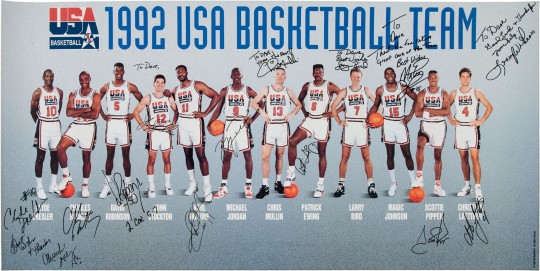
#clyde drexler#charles barkley#david robinson#john stockton#karl malone#michael jordan#chris mullin#patrick ewing#larry bird#magic johnson#scottie pippen#christian laettner#dream team#team usa#usa#nba#nba basketball#basketball#basketball legends#nba legends#legends#champions#shooting guard#point guard#power forward#small forward#center#1992 olympics#1990s#90s classic
1 note
·
View note
Text
The early 1990s were a golden era for Duke Basketball, with the 1992 team etching their names in the annals of college basketball history. In this article, we take a nostalgic trip back to the 1992 Duke Basketball Roster and their unforgettable journey.
The Dream Team
The 1992 Duke Basketball team, often referred to as the "Dream Team," was a blend of exceptional talent and tenacity. The Duke Men's Basketball Roster boasted players like Christian Laettner, Bobby Hurley, and Grant Hill, who would go on to become some of the Best Duke Basketball Players in history.
"The 1992 Duke Basketball team was a perfect blend of talent and tenacity, which was reflected in their performance throughout the season."
The Season
The 1992 season was a memorable one for Duke Basketball. The team started the season with high expectations, thanks to their impressive Duke Basketball Ranking. The Blue Devils lived up to the hype, delivering a series of thrilling performances that captivated fans and critics alike.
One of the standout games of the season was the Duke UNC Basketball match. The Blue Devils faced their arch-rivals in a thrilling encounter, with Duke emerging victorious in a closely fought contest.
The Coaching Staff
The success of the 1992 Duke Basketball team can be attributed in large part to the Duke Basketball Coaching Staff. Led by the legendary Coach K, the coaching staff was instrumental in guiding the team through the season. Their experience and expertise played a crucial role in the team's performance.
Highlights and Key Performances
The 1992 Duke Basketball season was filled with memorable moments and standout performances. From thrilling victories to hard-fought losses, the team showcased their talent and resilience throughout the season.
Standout Games
One of the most memorable games of the season was the Duke vs Pitt Basketball match. The Blue Devils faced a formidable Pitt team, which was ranked No. 25 in the AP Poll at the time. Despite the tough competition, Duke emerged victorious, showcasing their ability to perform under pressure.
Another standout game was the Duke vs Wake Forest Basketball match. The Blue Devils put on a stellar performance, demonstrating their offensive prowess and defensive tenacity.
"The 1992 Duke Basketball team showcased their talent and resilience in standout games against top-ranked teams."
Player Performances
The 1992 season saw some impressive performances from the Duke players. The Duke Basketball Stats for the season reflect the team's depth and talent. The players showcased their skills and determination, contributing to the team's success.
One player who stood out was Christian Laettner. His performances throughout the season earned him a place among the Best Duke Basketball Players. His skill and determination were instrumental in the team's success.
The Fans
The 1992 season also saw an outpouring of support from the fans. The Duke Basketball Forum was abuzz with discussions and debates about the team's performance. Fans showed their support by donning the Duke Basketball Shirt and the iconic Duke Basketball Jersey.
The Legacy of the 1992 Duke Basketball Team
The 1992 Duke Basketball team left an indelible mark on the sport. Their performances throughout the season showcased their talent, resilience, and determination. Let's take a closer look at the legacy of this remarkable team.
Impact on the Sport
The 1992 Duke Basketball team had a significant impact on the sport. Their performances throughout the season raised the bar for college basketball, setting new standards for teamwork and individual performance. The Duke Basketball Record for the season is a testament to the team's impact on the sport.
"The 1992 Duke Basketball team set new standards for teamwork and individual performance in college basketball."
Future Prospects
The 1992 season also saw the emergence of future stars. Players like Christian
Laettner and Grant Hill showcased their talent and potential, earning them a place among the Duke Recruits Basketball prospects. Their performances throughout the season caught the attention of scouts and fans alike, setting them up for successful careers in the sport.
The Fans
The 1992 Duke Basketball team also left a lasting impact on the fans. The excitement and passion displayed by the team throughout the season inspired fans around the world. The Duke Basketball Tickets were in high demand, with fans eager to witness the team's performances live.
The Duke Basketball Forum continued to buzz with discussions about the team's performances, with fans expressing their admiration for the team and their excitement for future seasons.
Conclusion
The 1992 Duke Basketball team will be remembered for their talent, resilience, and impact on the sport. From their standout performances to their impact on the fans, the team left a lasting legacy that will be remembered for years to come.
In this three-part series, we've taken a deep dive into the 1992 Duke Basketball season, exploring the team's roster, standout performances, and lasting legacy. As we look forward to future seasons, we can't help but be excited about what's to come for Duke Basketball. Stay tuned to SportyConnect for the latest and most accurate news on Duke Basketball and other sports organizations.
#SportyConnect
0 notes
Text
When you don't care about March Madness anymore because football money ruined the ACC and it's not the conference you grew up with, but your mother still loves it because she's just in it for love of the game. She used to play on a community women's team.
I should have paid some attention though. I would have tried to get tickets for her if I'd known in time that some of the first round was played here in my city.
I really miss what it was back in the day. My mother would make toast and chocolate milk and we'd watch the games together. And of course I will always remember Christian Laettner's shot at the buzzer in the Duke-Kentucky game.
Found a video!
youtube
I would have been 11 then. I remember screaming so much, lol.
Oh man that video has some good shots of Coach K. I miss him. I hope he's doing well.
#march madness#I bet they don't even let kids watch the tournament in school anymore#when I was in middle school they'd roll in those TVs#and let us watch as long as we also did our work#I don't know about now#but if you were in NC during the Coach K/Dean Smith era#college basketball was a huge cultural thing#oh god that tag makes me wonder if there's rpf slash of them somewhere lol
1 note
·
View note
Text
40 ANECDOTES SUR LA DREAM TEAM, LA MEILLEURE ÉQUIPE DE BASKET DE TOUS LES TEMPS
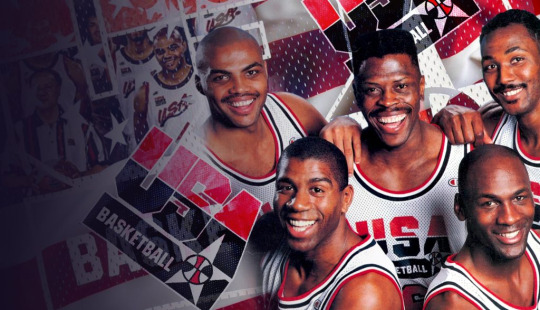
1. Avant les Jeux olympiques de 1992 à Barcelone, la Fédération internationale de basket-ball (la FIBA) interdisait aux joueurs évoluant en NBA de participer à la compétition.
La règle a été changée en 1989 suite à vote interne (56 voix pour, 13 voix contre)… et ce malgré l’opposition des représentants des États-Unis !
2. La raison principale qui a motivé cette évolution fut l’humiliation subie par la précédente sélection américaine lors des Jeux Olympiques de Séoul en 1988.
Défaite en demi-finale par l’URSS (82-76) en pleine Guerre froide, elle avait alors dû se contenter d’une piètre médaille de bronze, laissant échapper pour la seconde fois seulement depuis 1936 la médaille d’or.
3. Il a fallu deux ans pour sélectionner les 12 membres de la Dream Team.
Sous la houlette de C.M. Newtonn, directeur athlétique de l’université du Kentuchy et ancien assistant de coach de la sélection olympique de 1984, un comité a été formé constitué de cadres de la NBA (Rod Thorn et Jack McCloskey), d’entraîneurs universitaires (Mike Krzyzewski et P.J. Carlesimo), et d’un représentant des joueurs (Charles Grantham).
Le comité a ainsi passé en revue les saisons 1990-91 et 1991-92 avant de rendre ses recommandations.
4. Les noms des joueurs sélectionnés ont été dévoilés en direct lors d’une émission de télévision spéciale diffusée sur la chaîne NBC.
Sur les 12 places disponibles, seules 10 ont toutefois été annoncées.
5. Clin d’œil aux olympiades passées, choix a été fait de réserver la douzième place à un joueur universitaire.
Si avec le recul, le fait que Christian Laettner ait été préféré à Shaquille O’Neal paraît aberrant, à l’époque, sa sélection ne souffrait d’aucune contestation. 4 Finals Four, 2 titres de champions NCAA, record du plus grand nombre de points marqués, de lancers-francs et de matchs joués lors de la March Madness, il était (et est toujours) un sérieux prétendant au titre de meilleur basketteur universitaire de l’histoire.
Ce fut la toute dernière fois qu’un joueur NCAA participa aux JO.
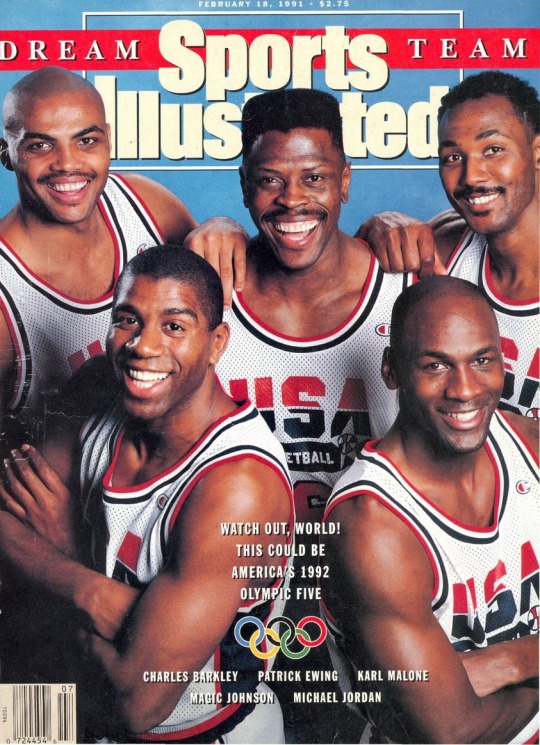
6. Christian Laettner traîne depuis la réputation d’être le joueur le plus mal-aimé de la NBA.
Blanc, beau gosse, cadet de la bourgeoise, compétiteur pas toujours correct… sa personne cristallisait un peu malgré lui rancœur et jalousie – voir à ce sujet le documentaire : I Hate Christian Laettner produit par ESPN en 2012.
7. C’est peu dire que la lutte pour la dernière place a été disputée.
Face à Dominique Wilkins, Kevin Johnson, Tim Hardaway et l’étoile filante Michael Adams (26,5 points de moyenne et 10,5 passes décisives par match en 91/92), c’est Clyde Drexler qui remporté la mise suite à saison monstrueuse avec Portland (25 points assortis de 6.6 rebonds et 6,7 passes, il ne tient qu’à Jordan de l’avoir privé du titre de MVP et d’une bague de champion),
8. Michael Jordan a dans un premier temps refusé de rejoindre la sélection américaine.
Pas franchement emballé à l’idée de faire une croix sur ses vacances d’été, il était en sus épuisé par sa dernière saison.
De son propre aveu, il a essayé du mieux qu’il pouvait de « trouver une manière gracieuse de décliner l’invitation ».
9. Une fois embarqué, Jordan n’a cependant pas pris à la légère le tournoi olympique : contrairement à tous ses coéquipiers, il tenait à étudier chacun de ses adversaires en vidéo avant les matchs.
10. Autre gros nom réticent à prendre part à l’aventure : Larry Bird.
Sérieusement handicapé par une blessure au dos, il souhaitait initialement partir à la retraite à l’issue de la saison 91/92.
Il a alors fallu toute l’obstination de son pote Magic pour le faire changer d’avis. Non content de l’avoir appelé des dizaines de fois, il a fini par le menacer de ne pas venir s’il ne venait pas.
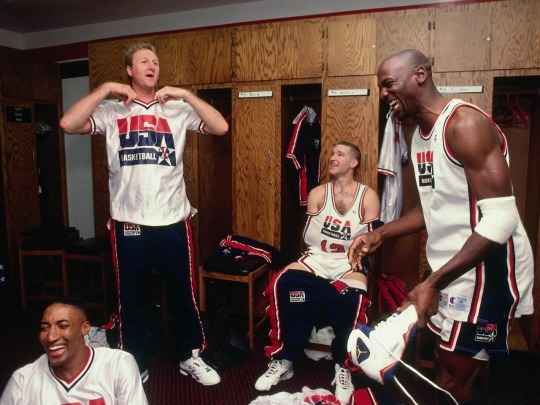
11. Âgé de 35 ans, Larry Bird était non seulement le joueur le plus âgé de l’équipe, mais il reste encore à ce jour le joueur le plus âgé ayant évolué au sein d’une sélection nationale américaine de basketball.
12. John Stockton est passé à deux doigts d’être remplacé par Joe Dumars.
Blessé au tibia, le meneur des Utah Jazz était incertain jusqu’au dernier moment. S’il a réussi à se remettre d’aplomb à la surprise générale, il n’a cependant joué que quatre matchs de tout le tournoi.
13. Grand absent de la sélection, Isiah Thomas n’a pas été retenu raison extra-sportives.
Seul joueur de l’histoire à pouvoir se targuer d’avoir battu Magic Johnson, Larry Bird et Michael Jordan au sommet de leur art, il avait beau être l’un des meilleurs meneurs de la ligue, pas mal de membres de la Dream Team ont catégoriquement refusé qu’il intègre la sélection (Jordan, Pippen et Barkley en tête).
Leader des fameux Bad Boys, la cuvée des Detroit Pistons tristement célèbre pour son jeu défensif ultra-agressif, il était cordialement détesté sur les parquets et en dehors.
14. Contre toute attente, Chuck Daly, l’entraîneur des Bad Boys, et Michael Jordan se sont entendus à merveille.
Partageant une passion commune pour le golf, les deux hommes se sont retrouvés autant de fois qu’ils ont pu sur les parcours de la région.
15. Les membres de la Dream Team cumulent 15 titres de MVP de la saison régulière.
Jordan en a glané six, Bird et Magic trois chacun, Malone deux, Robinson et Barkley un chacun.
À l’exception d’Hakeem Olajuwon en 1994, ils se sont adjugés le trophée de 1983 à 1999.
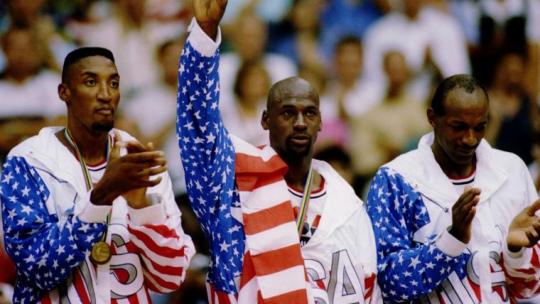
16. Les membres de la Dream Team cumulent 23 bagues de champion NBA.
Jordan et Pippen en ont six chacun avec les Bulls, Magic cinq avec les Lakers, Bird trois avec les Celtics, Robinson deux avec les Spurs, et Drexler un avec Houston.
17. Les 12 membres de la Dream Team combinent au total 117 apparitions au All-Star Game !
Michael Jordan et Karl Malone sont ceux qui cumulent le plus grand nombre d’apparitions au match des étoiles (14 sélections chacun).
18. Lorsqu’en 1997, la NBA a dévoilé sa liste des 50 meilleurs joueurs de tous les temps (la seule, la vraie), dix des douze Dream Teamers y figuraient.
Seuls Chris Mullin et Christian Laettner ont été omis.
19. Quand il a été demandé à Charles Barkley ce qu’il savait de l’Angola, le premier adversaire de la Dream Team à Barcelone, le futur Sun a répondu : « Rien, si ce n’est que l’Angola est dans de beaux draps » (« I don’t know anything about Angola, but Angola’s in trouble »).
Visionnaire, les Américains leur ont infligé 68 points de différence (116-48), le plus gros écart de points du tournoi.
20. La Dream Team a remporté les huit rencontres du tournoi olympique avec 43,8 points d’écart en moyenne.

21. Avec 117,3 points par match, la Dream Team détient encore à ce jour la moyenne de points marqués la plus haute de l’histoire des Jeux olympiques.
Si l’on considère les six autres matchs internationaux disputés par la Dream Team, cette moyenne se porte même à 118, 9 points par match !
Pas une seule fois, la Dream Team n’a marqué moins de 100 points dans un match.
22. Tandis que la Dream Team a rentré 57,8% de ses paniers lors des JO, face à elle ses adversaires se sont contentés d’un maigre 36,5% de réussite.
23. De tout le tournoi, la Dream Team n’a été menée qu’une seule fois, lorsqu’à l’entame de son match contre l’Espagne, ils ont encaissé un 4-0. Les Américains sont cependant vite revenus et ont défait les Espagnols 122-81.
24. Chuck Daly n’a pas demandé un seul temps mort du tournoi.
25. Charles Barkley a terminé meilleur marqueur du groupe avec une moyenne de 18 points par match à 71,1 % de réussite.
C’est face au Brésil qu’il a réalisé sa plus grosse performance en marquant 30 points (12 sur 14 aux shoots).

26. À la fin de chacun de leurs matchs, les joueurs des équipes adverses leur demandaient systématiquement de leur signer des autographes et de prendre des photos avec eux.
27. L’équipe qui a donné le plus de fil à retordre à la Dream Team fut la Croatie. En finale, elle ne s’est incliné « que » de 33 points d’écart (103-70).
28. Lors de la finale, Michael Jordan et Scottie Pippen se sont acharnés du mieux qu’ils pouvaient sur Tony Kukoc.
L’histoire commence en 1990 quand le Croate est drafté par les Chicago Bulls. S’il n’a rejoint l’équipe qu’en 1994, durant ce laps de temps, Jerry Krause, le General Manager des Bulls, lui tresse des lauriers publiquement à chèque fois que l’occasion se présente.
En bisbilles avec Krause sur les plans personnel et professionnel, Jordan et Pippen décident de se venger indirectement en s’attaquant au pauvre Kukoc, 22 ans.
« Je voulais l’éteindre complètement. L’embarrasser. » expliquera Pippen qui, avec MJ, passent le match à défendre au plus près du Croate.
Complètement asphyxié, ce dernier termine la rencontre avec quatre petits points et un très pauvre 2 sur 11 aux tirs.
29. Michael Jordan a bien failli ne pas monter sur le podium lors de la cérémonie de remise des médailles.
Par fidélité envers Nike, il refusait en effet de se montrer en survêtement Reebok, le sponsor officiel de la Dream Team.
Présent dans l’assistance, Phil Knight, le PDG de la marque au swoosh, est intervenu pour suggérer un compromis : que Michael porte le drapeau des États-Unis sur ses épaules pour cacher le logo de l’équipementier britannique.
30. Karl Malone a inscrit le tout premier panier de la Dream Team, ainsi que le tout dernier.
Contre l’Angola, après 11 secondes de jeu. Contre la Croatie, en finale, à 4,1 secondes de la fin.
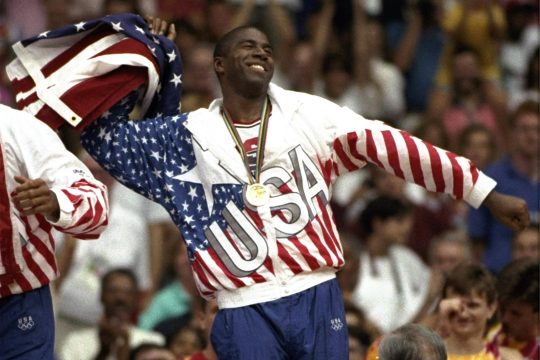
31. Contrairement à tous les autres athlètes, les basketteurs de la Dream Team ne logeaient pas au village olympique, mais dans un hôtel quatre étoiles à Barcelone.
Un choix motivé par des raisons de sécurité.
« Personne n’était plus protégé qu’eux lors des Jeux » se souvient Horace Balmer, le chef de la sécurité. « Aucun véhicule n’était autorisé à stationner à deux rues à la ronde. Des hélicoptères surveillaient les lieux. »
32. Tout ce luxe n’a pas empêché Charles Barkley de pester auprès du personnel que les World Series de baseball n’étaient diffusées sur aucune chaîne.
33. De tous les membres de la Dream Team, John Stockton était le seul à pouvoir déambuler incognito dans les rues espagnoles – voir cette vidéo hilarante où il tombe sur une touriste US vêtue d’un t-shirt aux couleurs de la sélection américaine et qui ne le reconnait même pas.
34. La quinzaine olympique a donné lieu à des parties de poker endiablées entre les membres de la Dream Team.
Si l’on en croit Magic Johnson, le soir venu, lui, Jordan, Pippen et Barkley passaient des nuits à jouer aux cartes.
Compétiteur obsessionnel, Jordan refusait d’aller se coucher tant qu’il ne gagnait pas, quitte à ne pas dormir de la nuit quand bien même il y avait match le lendemain. Magic raconte même qu’il a une fois enchaîné deux nuits blanches d’affilée, avant d’aller jouer au golf au petit matin, puis d’aller jouer l’après-midi la demi-finale contre la Lituanie.
35. Durant les entraînements, Michael Jordan chambrait tellement Clyde Drexler que ses coéquipiers lui ont demandé de lever le pied.
Quelques semaines plus tôt, MJ avait en effet trouvé Drexler sur sa route en finale NBA. Passablement agacé de la comparaison qui était faite entre lui et l’arrière des Portland Trailblazers, il avait tenu à mettre les choses au clair dès le Game 1 en plantant six paniers à trois points lors de la première mi-temps, un record.
Visiblement toujours pas calmé une fois arrivé à Barcelone, Jordan a passé son temps à remuer le couteau dans la plaie en lui remémorant dès qu’il le pouvait son petit exploit (« Tu te souviens comme je t’ai botté le cul Clyde ?… Tu as cru que tu pouvais m’arrêter Clyde ?… Tu feras gaffe à ces trois points cette fois Clyde ?… »).

36. Ce pauvre Clyde Drexler a en plus dû subir les railleries de ses petits camarades toute la quinzaine pour ses supposés « deux pieds gauches ».
Au cours d’un des premiers entraînements de la Dream Team à Monte Carlo, Drexler avait dû s’habiller en urgence et avait enfilé par mégarde deux chaussures destinées au pied gauche.
Pas de chance pour lui, Charles Barkley s’est empressé de le faire remarquer au reste de l’équipe. L’incident a alors très vite fait office de running gag.
37. La Dream Team a affronté la Dream Team.
Lors de la préparation à Monte Carlo, la rivalité entre Michael Jordan et Magic Johnson était telle qu’au cours d’un entrainement, un match a été improvisé pour crever l’abcès.
Jordan s’est ainsi allié à Malone, Pippen, Ewing et Bird. Magic à Barkley, Robinson, Mullin et Laettner.
Si la team Magic a rapidement pris l’avantage (16-7), le meneur des Lakers a ensuite eu le malheur de chambrer le Bull un peu trop fort (« Hey, the Jordanaires are down »). Conséquence, le match s’est fini sur un 40-36 en faveur desdits « Jordanaires ».
MJ a un jour qualifié ce match de « meilleur match de sa vie ».
« Le gymnase était fermé, nous n’étions là que pour le basket. »
38. Oui, la Dream Team a connu la défaite.
Pire, ce fut contre une équipe composée d’universitaires qui pour la plupart n’ont ensuite jamais brillé en NBA, Grant Hill et Chris Webber exceptés.
Désireux de faire comprendre à ses joueurs qu’ils ne sont pas aussi invincibles qu’ils le croyaient, et qu’ils devaient faire l’effort de travailler leur cohésion, Chuck Daly avait mis sur pied ce match sans les prévenir.
Pris de court, les futurs Hall of Famers se sont inclinés 88-80.
Une revanche a alors été organisée le lendemain. Piqués au vif, ces messieurs les pros ont cette fois collé une raclée aux écoliers.
« Je crois qu’on leur a mis 100 points » racontera plus tard Charles Barkley. « On les a battus comme s’ils avaient volé quelque chose ».
39. Bien que la Dream Team soit largement considérée comme la meilleure équipe de basket de tous les temps, Shaquille O’Neal a affirmé à plusieurs reprises que la Drema Team 2 aurait pu venir à bout de la bande à Jordan, Magic & Co.
Idem pour Kobe Bryant et LeBron James qui ont prétendu que la Team USA de 2012 aurait pu l’emporter.
40. L’épopée Dream Team marque le début de la mondialisation des effectifs NBA.
Tandis qu’en 1992 seuls 23 joueurs évoluant dans la ligue n’étaient pas américains, ce sont désormais plus d’une centaine d’internationaux qui sont décomptés chaque année.
Ce sont ainsi pas moins de 39 nationalités qui se côtoient sur les parquets.

Publié sur Booska-p.com le 5 août 2022.
0 notes
Video
youtube
Christian Laettner's shot sinks Kentucky in 1992 Elite Eight
0 notes